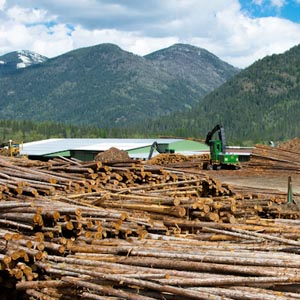National Forest Week and Wood Innovation
During last week's National Forest Week (September 18 to 24), Canadians are encouraged to appreciate our world-class forests.

Pictured from left to right: Derek Nighbor, CEO Forest Products Association of Canada (FPAC); Michael J. Giroux, President, Canadian Wood Council; Pierre Lapointe, President and CEO FPInnovations — Photo: (FPAC), Canadian Wood Council, FPInnovations
Forestry is an important employer in the Kootenays with 11 forestry companies in our list of the Top 50 companies, representing over $1.5 billion in annual revenue. Nationwide, almost 290,000 Canadians are employed directly or indirectly in the forestry sector.
During last week's National Forest Week (September 18 to 24), Canadians are encouraged to appreciate our world-class forests. This year’s theme for National Forest Week was True North: Strong and Green. Canada’s forest sector is stronger, more diverse and more high-tech than ever.
Here is an interesting article on the innovative uses of wood in building today, from the Forest Products Association of Canada:
Tall Wooden Buildings Reaching New Heights
You won’t read about it in the sports section any time soon, but a number of Canadian cities are competing in a high-stakes global race that will directly affect more than 200 of our communities.
The cities – including Vancouver, Toronto, Montreal, Québec – are competing in an amazing race against a number of cities around the world to build the tallest wooden high-rise buildings. The results of this race, for Canadian workers, companies, and the environment, are critical.
In Vancouver, for example, it’s a 18-storey student residence at the University of British Columbia that is already under construction, and will soon be one of the tallest mass timber hybrid buildings in the world. In Québec City, the ground was broken in mid-June on a 13-storey condominium complex that will include 12 stories of timber.
There’s no mystery to this trend. Builders have always held wood products in high regard because they are widely available, cost-effective, quick and easy to use,durable, and, of course, great looking. But their popularity has grown in recent years for other reasons.
First of all, they’re great for the environment. Forest products are of course sustainable and trees act like nature’s vacuum in the way they absorb carbon, thereby reducing the greenhouse gases that lead to climate change. Trees actually absorb the most carbon when they’re young and growing and become net emitters as they age. When turned into wood products, however, the carbon is sequestered.
Secondly, innovation in the forest products sector has made wood, always popular with consumers, even more attractive to builders. One of those innovations, cross-laminated timber (CLT), is particularly important in this trend toward wooden, high-rise buildings. CLT is a multi-layered wooden panel where layers are stacked perpendicularly and then glued together using hydraulic or vacuum presses. From a builder’s perspective, the end result is a material that is faster and less costly to use, stronger, able to be turned into panels off-site and ahead of time (no matter the weather), and sustainable. On top of all of that, because they have heft and the strength of steel, CLT panels have shown to be resistant to both fire and earthquakes, making this innovation superior in many applications to competing products.
No surprise then that it’s not just Canadian builders and communities that are starting to wake up to the many benefits of wood. In London, England, a 100-storey wooden tower has been proposed, as has a 40-storey building in Stockholm, and new tall wood buildings in Australia, Austria, Norway and the United States, just to name a few.
Even though the majority of Canadian communities haven’t yet adapted their building codes to allow wooden structures beyond either four or six stories, wood is clearly gaining ground. Code changes that permit the use of light-wood frames and massive timber for buildings up to six-storeys high, which were included in the 2015 version of the Canadian building code, have been adapted and adopted by Ontario, Quebec and Alberta. British Columbia led by adopting a similar provision into its building code in 2009.
Changes to the national building codes for wood buildings up to 12 storeys, involving the use of massive timber, have been proposed by the Canadian Wood Council. Quebec has led the way on this matter by developing an alternative code for these types of buildings.
So wood is reaching new heights – and for all the right reasons.Natural Resources Minister Jim Carr said of federal investments in wood R&D: “[They] lead to cleaner, more sustainable construction practices, all while promoting the creation of employment opportunities in the forestry sector. Innovative, entrepreneurial ideas like these are integral to our flight against climate change.”
Canada is off to a good start in the race to make taller, wooden buildings. For the sake of our forest products industry, more than 200 Canadian communities whose economies rely on it, 237,000 employees, and our environment, let’s hope we cross the finish line as soon as possible.





Comments